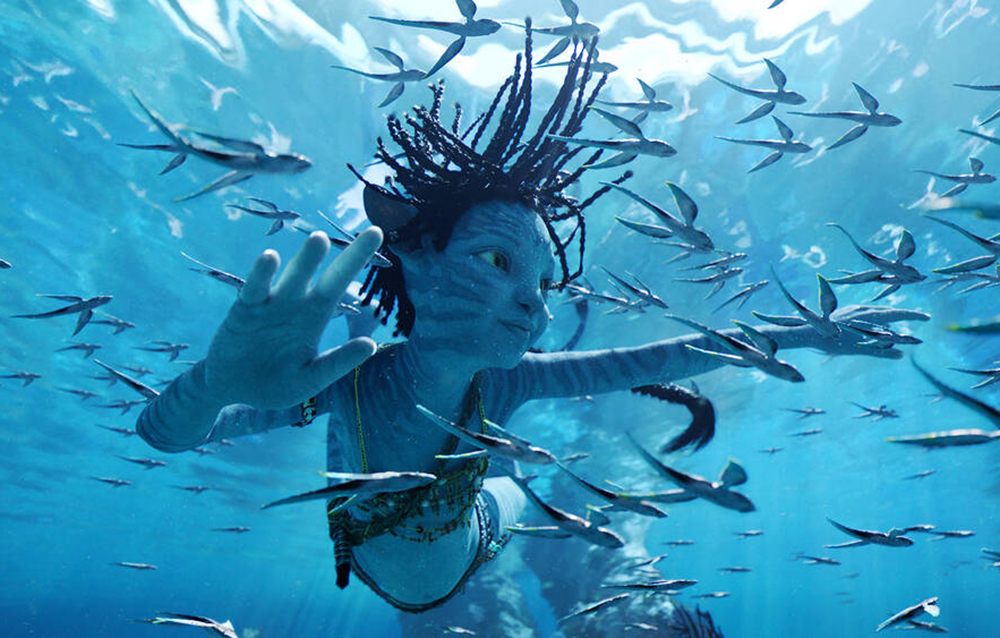It’s amazing to think, that in the world of modern, big screen cinema, that “Avatar”—a film from 2009—is still one of the highest grossing films of all time. However, that is the power of James Cameron; as until 2009, “Titanic” was the highest grossing film of all time, making Cameron a billon dollar director. When Cameron announced he would make a sequel to the film, there was a lot of buzz in the industry. People were keen to see if the second film—titled “Avatar: The Way of Water”—would have as much influence as the first film did, particularly for its visual effects.
The sequel follows Jake Sully (Sam Worthington) and his newfound family. The plot takes place a decade after the end of the first installment. Jake now keeps his blue Na’vi form; he has taken up residence in Pandora with his wife Neytiri, and they now have several children.
Bringing Back Familiar Elements
The Sullys have fostered a son, Spider, who’s human but identifies as a Na’vi. However, he’s the biological child of Jake’s archenemy, Colonel Miles Quarich (Stephen Lang), who lost his life in “Avatar.” Despite this, Quarich returns as the villain again here. He’s now in the form of a Na’vi, but has the Colonel’s memories inside of him, igniting his feud with Sully who betrayed him. (*spoilers*) Miles destroys Pandora again, forcing the Sullys to vacate their beloved land and find home elsewhere. Their new home is the island of Metkayina, and the people that inhabit it are creatures of the sea; they have a greenish colour to them, which contrasts against the Na’vi blue. They have remained undisturbed by the Sky People. However, once Jake turns up (with Miles in tow), that quickly changes. A showdown follows, lasting for the last 3/4 of the film. (*end spoilers*).
“The Way of Water’s” plot is somewhat predictable and simple—we have a villain trying to kill a man who betrayed him, ending in a massive fight where both him and his family may be in danger. However, the visual effects are what elevates this film to be on par with the first film, if not a bit better. The underwater sequences are that much more spectacular when you know that the actors did it all without oxygen, and learned to hold their breath for up to seven minutes. It was widely acknowledged that Kate Winslet, who plays The Metkayina Queen, held her breath for 7 minutes and 15 seconds, beating Tom Cruise’s record of six and a half minutes.
A Simplistic Story, but Made up for by its Visuals

The scenes of the Sully family are lengthy sequences, which really showcases the aquatic world Cameron has created. When “Avatar” came out in 2009, people who left the cinema became actually depressed that they weren’t able to visit Pandora in real life, and this beloved land does feature prominently in the sequel. However, the emphasis is on the new island of Metakyina, and the attractions that live below the land. By showing scenes of the children of both tribes engaging in adolescent bonding—by riding the island’s long-necked creatures through the sea—the film then becomes a trippy, underwater ride. The 3D elements of this film only emphasises this. It is state of the art and never too flashy, and makes the underwater sequences come alive on-screen.
The film’s biggest hurdle is that with the first installment, the fascination of it was people seeing Pandora for the first time, and also experiencing that level of immersive 3D. People are now used to seeing this world, so it’s a good thing on Cameron’s part that he introduced us to a new island, which then becomes the most captivating part of the film. It has been reported (though some aspects of it are being debated), that there are to be three more sequels of “Avatar,” taking us up to December 2025. And as the plot of “The Way of Water” was very simple, let’s hope Cameron can deliver a more complex story for the continuation of The Sully’s adventures.
“Avatar: The Way of Water” is currently only available to watch in cinemas.



1 Comment
The Only Version Of 2009’s Avatar That I Prefer Is The Original 2009 Theatrical Version (162 Mins).